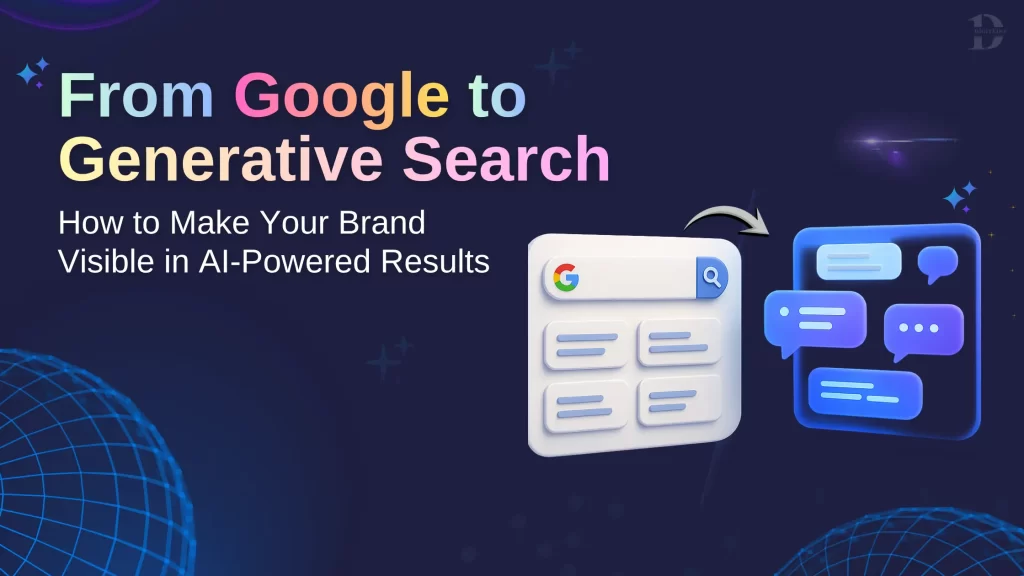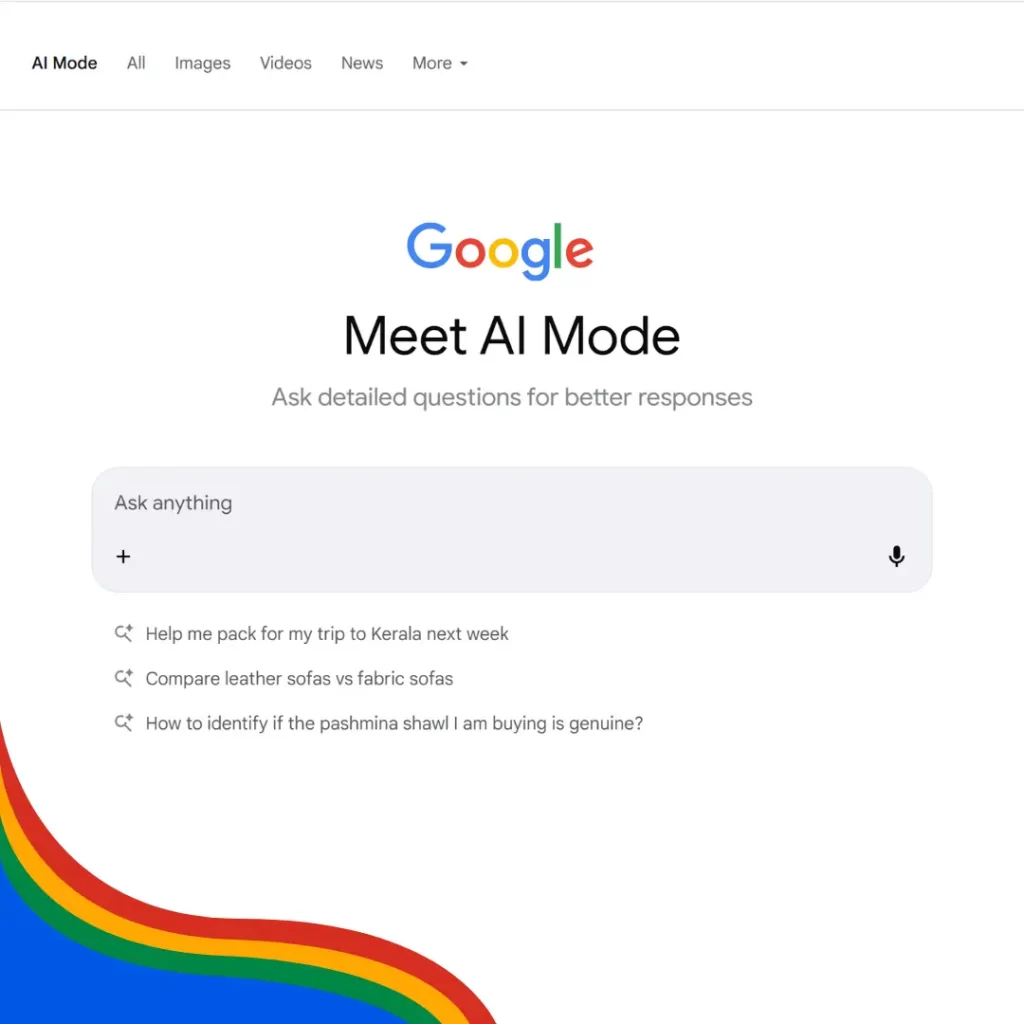Google has dominated the digital marketing scene in the last twenty years.
Here, the brands competed on page-one positioning, the search engine optimization gurus optimized the keywords, and the links were the currency of visibility.
Today, that world is changing. The concept of AI-driven search engines, such as the Search Generative Experience (SGE) of Google and the Perplexity AI, ChatGPT Search, and Gemini, is challenging the current ways users access information.
These engines do not show ten blue links, as such engines generate answers through artificial intelligence. They provide summaries, sources, and in many cases, have everything one needs without having to click a button.
This change implies that now the visibility will not only depend on your position on Google, but also on whether the AI systems will identify and mention your brand.
Now, how do you guarantee that your content will feature in such AI-generated search results? Let’s explore.

Traditional Search to Generative Search
Conventional SEO: The Link Model
The old-fashioned SEO was all about proving to search engines that your site was the most suitable one in connection to a keyword. Google examined backlinks, keywords, and page organization to rank websites.
An ordinary type of search query, such as best CRM tools 2026 gave a list of links. Users then selected the links to be clicked.
That approach is changing.
Generative Search: The AI Model
Contemporary search engines are more like a personal assistant than a library person. Asking it to answer the question of what the best CRM tools are in small businesses, the AI reads you a paragraph summarizing the best options and refers to numerous other sources.
According to the Gartner 2025 Search Trends Report, there are more than 30% of queries around the world are already being answered by generative systems, and the proportion might go to 60% by the year 2026.
Being a single one of many links is no longer an option; your site must become the trusted source that the AI incorporates into its answer.
Why This Matters
Failure to understand, contextualize, or verify what you post with the use of AI systems may make your brand fade into the discussion. Visibility nowadays is to be mentioned, summarized, or referred to in AI responses.
Why Most Brands Are Finding themselves out of sight in AI Search.
At Digiteins, we observe the existence of companies that use the same-old SEO strategies, which are no longer effective in the AI-driven world. These are the most widespread errors.
A. Keyword Stuffing and Old-Fashioned copy.
AI search engines do not use repetition of keywords; rather, they use semantic understanding. Pages that are loaded with keywords are not found in the AI-generated responses.
Solution: Use natural and conversational writing. Use important phrases where applicable and emphasize purpose and not density.
B. Repackaged or Repurposed Content.
Generative engines appreciate experience, innovation, and precision. Articles whose content is too thin or those that need to be copy-pasted are immediately discarded.
The answer: Share new information, new knowledge, and real-life stories. As an illustration, an example that demonstrates the effectiveness of a structured-data approach in increasing AI citations generates authority.
C. Missing Structured Data
Plain text is less accurate and slower to process using AI systems than structured data. Without schema markup, you do not have a machine-readable context for your content.
Solution: Shared schemas like Article, FAQPage, and HowTo are to be implemented to define both content purpose and content relationships.
D. Lack of E‑E‑A‑T
Both Google and generative engines are still based on Experience, Expertise, Authoritativeness, and Trust ( E-E-A-T). Unauthenticated or unidentifiable material is downranked.
Suggestion: Add bios of the author, use credible works, and prove your word using genuine examples.
Understanding Generative Engine Optimization (GEO)
SEO is then followed by Generative Engine Optimization (GEO). Conventional SEO aims at ranking in search engine results, whereas GEO aims at making it to AI-generated responses.
It involves the production of content with:
- Machine‑readable
- Contextually rich
- Credible and data‑driven
- Authoritative and trusting.
The fundamental question that GEO provides is the following:
Will your brand feature in an AI engine search engine summary of your topic?

How to make your brand visible in AI-Powered Results.
The following is a step-by-step outline that you can use in the present day.
Step 1: Focus on Questions, Not Keywords
Search behavior is converting to talkative. People will no longer type in the search query SEO agency India but rather say, What is the AI search optimization agency that optimizes business?
AI engines examine context, intent, and natural phrasing, rather than frequency of keywords.
Actionable Tips:
- Use long and conversational headings (e.g., Why is my website not in AI search results?).
- Write in a familiar human way.
- Add FAQ pages in order to address question-based searches.
Step 2: Add Organized Data and Out Structured Formatting
Structured information is read more efficiently by the generative engines. Schema markup indicates the content of your page.
These fundamental schema types will be required:
- Article
- FAQPage
- HowTo
- Organization
- Person (for authors)
Actionable Tips:
- Test your schema with the Rich Results Test by Google.
- Increase the use of bullet points, tables, and numbered lists because AI finds content easier to decode.
- Keep up the heading structure (H1, H2, H3).
Step 3: Data-driven Strengthening of Authority
AI systems have a tendency to cite sources that are supported by evidence. Information is credible to readers and robots.
Actionable Tips:
- Include statistics and reference them in a proper way (e.g., HubSpot 2025 SEO Report has found that 68% of marketers are now optimizing their search visibility to AI).
- Use industry data, first-party data, or client work performance data.
- Associate with credible websites and government, or research materials.
In the case of content that proves to be factual, AI engines consider it as a reliable source.
Step 4: Keep Technical SEO Healthy.
Technical SEO cannot be ignored even in the AI-driven world. In the absence of a solid base, your site can be overlooked or misunderstood by the AI crawlers.
Checklist:
- Enhance site speed (less than 3 seconds).
- Use secure HTTPS protocols.
- Make sure it is mobile responsive.
- Simplify URL structure.
- Make sitemaps current and faultless.
These search engine guidelines are going to enhance crawlability and increase the possibility of being indexed in both traditional and generative search.
Step 5: Brand Recognition on the World Wide Web.
AI engines put an emphasis on brand consistency and omnipresence throughout the digital ecosystem.
Actionable Tips:
- Take the same naming, tone, and branding everywhere.
- Promote the use of links and references to high-ranking websites.
- Make appearances in the topical directories, news sources, and discussions.
- Post thought-leadership articles and interviews.
The more your brand is mentioned on the internet, the more AI is likely to incorporate it in its sets of answers.
Step 6: Measure AI Visibility Metrics.
Traditional measures like the position of keywords are less applicable in the times of generative search. Rather, follow the uses of AI systems for you.
New KPIs to Monitor:
- References in AI-generated summaries.
- Mirrors in ChatGPT, Perplexity, and SGE responses.
- References of the brand on AI-driven browsers.
- Referral traffic of AI search engines.
Test on new GEO tools like SEO.ai or NeuronWriter to see your content being tested in AI search systems.
Practical Example
Suppose that Digiteins has written the article called How AI is Changing SEO to Content-Heavy Brands.
You include:
- Schema Article and FAQPage.
- Discussion headings, such as What makes AI SEO different than traditional SEO?
- Revised information, including Generative engines, now contributes 32 percent of search traffic in the world in 2025.
- Authors with confirmed LinkedIn accounts.
When a user enters a query into an AI engine, such as, How can I optimize content to AI search engines, it searches through several sources. Due to the original structure, referencing, and credibility of your article, the AI can add your brand to the synthesized response:
Digiteins notes that to rank well with AI SEO, structured data, conversational content, and credibility of expertise need to be found in the generated search results.
And that is contemporary visibility: to be mentioned, and not ranked.

The Future of AI Search
In a study conducted by Ahrefs and HubSpot in 2025, the following trends are found important:
- One-half of the users now believe in AI generated answers more than traditional answers.
- In 2023, AI systems are already citing 25% more sources of brand than in 2023.
- One out of every five marketers intends to incorporate AI visibility optimization in his/her 2026 plan.
- Generative search is not a short-lived trend. It forms the basis of the way people will discover and experience content over the coming five years.
Conclusion: Don’t Just Rank, Be Referenced
The transition to generative search is changing the manner in which brands reach out to the audience. It is no longer sufficient to rank on page one. The new objective is to feature in the responses that AI provides to users.
In order to be successful in this landscape, you need to produce conversational, structured, and data-driven content. Exercise actual control and create online credibility.
It is no longer the search that depends on the keyword search visibility, but rather the search visibility being the recognition of a source of truth by AI systems.
In the case of progressive brands, this is no danger. It is an opportunity to lead.
Start today. Optimize your current content to be readable by AI, revise your design, add schema, and position your brand as an expert of trust. In the new search age, winners are the first ones to change.



